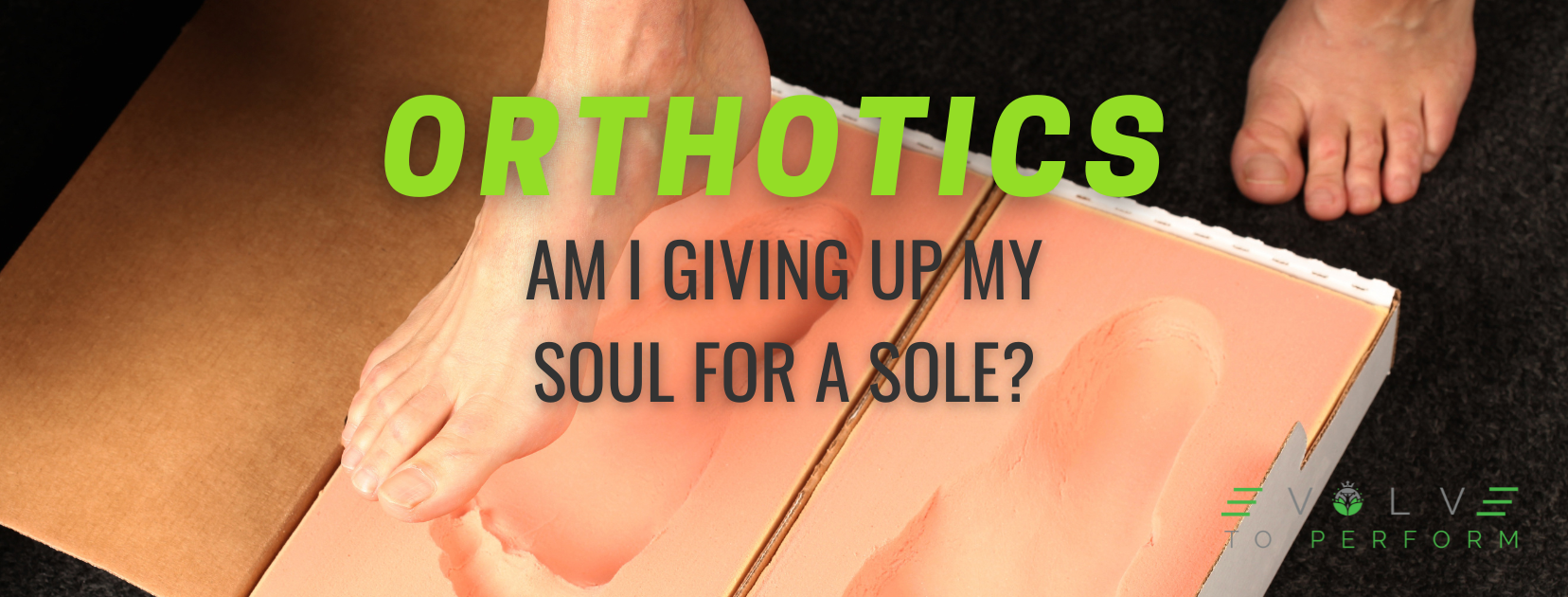
08 Apr Orthotics: Am I Giving Up a Soul For a Sole?
By: Dr. Kingsley Yew, DPT
For those of you that have low arches, weak feet or any other reason you’ve been told you need orthotics, it makes total sense that adding support would solve all of your problems.
But does it come at a price?
As a father to a teenager and 2 pre-teens, I’m familiar with playing the heel. So I’m going to try my best to inform you about my stance on orthotics, who it’s good for, what it’s good for and what are some steps that you can take in the right direction to free yourself from a life of dependency from something that is seemingly unnatural.
What is an Orthotic?
To clarify, an orthotic does not have to be an expensive pair of custom made insoles. It is any type of insert that you use to alleviate foot pain or shoes that are meant to control motion of the foot.
The human foot is a beautifully sculpted piece of human engineering. It consists of bones, joints and arches that are designed to shield us from impact, absorb it and return it in dynamic ways that allow our species the ability to outlast any land based mammal on the planet in terms of sheer efficiency and versatility. Our feet are nimble enough to balance us on ice, yet strong enough to walk on hot coals and resilient enough to carry us and walk, even after running an ultramarathon.
And yet, with these innate capabilities, there is a school of thought that we have to supplement the foot with extra lifelong protection, support or stability.
Are there certain conditions that are appropriate for orthotics? Of course. Without saying anything in totality, there are conditions like Charcot Foot that require external support due to involved disruptions of neural signals that impair overall sensation & function. Episodes of acute pain that affect how you walk and bear weight are also a time when orthotics would be fitting. But prolonged or permanent usage of orthotics for common reasons such as flat feet, plantar fasciitis, hallux rigidus, bunions, heel spurs, shin splints, posterior tibialis tendonitis and heel cord injuries are not. Mainly because of the effect that orthotics play on the intrinsic muscles of the foot.
The Intrinsic Muscles
There are 4 layers of muscles that make up the intrinsic muscles of the foot. When working efficiently and together in concert, they congregate to maximize how well all 26 bones of the foot meet (AKA – joint congruency of all the foot joints), to make up the dome of the foot. It’s like putting the pieces of a well-fitting 3-dimensional puzzle together without effort. But more importantly, fully functioning intrinsic muscles help to slow down the arch as it softens to absorb energy and naturally flattens, which is also known as pronation. Pronation is important because it in turn then sets the foot up to stiffen and return energy, which is known as supination. And fully functioning intrinsic muscles also help keep toes where they need to be to provide the steady foundation we need to stand, balance and propel ourselves efficiently.
It’s been found that orthotic use in non-injured people decreases the cross-sectional area of the intrinsic foot muscles in as little as 12 weeks. This is important because, unless you’re looking to lean down that foot to fit into that glass slipper, a loss of muscle size also correlates with a loss in muscle strength & output.
Don’t Underestimate the Power of the Force of the … Windlass Mechanism
Although it’s been shown that EMG activity of the intrinsic muscles are highest during running, we can’t expect you to start running right away, especially if it’s been a while since you’ve run or you’re fresh out of the acute or sub-acute phases of recovery. So be mindful of your walking.
During walking, intrinsic foot muscle activity is highest during the late stance, which is when the trail leg is behind the body and the big toe is flexed upward as the heel lifts. This is a key to untapping the hidden potential of the foot because it enables you to use the mechanical leverage from a phenomenon of the foot called the Windlass Mechanism. Upward toe mobility also happens to be one of the keystone movements that we look for during an evaluation. If you find that you have some limitations with big toe extension, there are a plethora of ways to improve your movement capacity. All you have to do it ask us and we’d be happy to share.
Steps in the Right Direction
Going after the lowest hanging fruit first, one exercise that you can start with to develop communication with the intrinsic muscles is the Short Foot exercise. This exercise has been found to be more effective than Towel Curl exercises to reconnect with the intrinsic foot muscles.
As mentioned earlier. Although orthotics in the acute phase of an injury helps to bridge the gap by reducing pain and compensations and mindful walking can help restore the natural dynamics of the foot, you have to at some point in time start taking yourself through the Orthotic Elimination Diet. #trademark
Just like any new habit or change, this process can take weeks to months.

Walking in minimalist shoes has been shown to increase intrinsic muscle cross-sectional area in as little as 8 weeks. Some of my favorite minimalist shoes are Vivobarefoot, Vibram Fivefingers & Xero. As you continue to develop your tolerance for walking in minimalist shoes, you can also supplement your training with barefoot squats, loaded carries, lunges, etc ….
To step it up a notch, adding more demanding forces and athletic movements to load the foot like the Sled Push and Active Foot exercises are solid options if you’re looking to get back to more dynamic activities such as running and return to sport.
“You’re Only as Old as Your Feet.”
~ Kelly Starrett quoting a Russian probably quoting someone else
If I can’t convince you to ditch long-term use of orthotics because it will likely lessen the chances you will suffer from an injury again and boost your genetic expression as an athlete, then another reason for investing the time to strengthen your feet is because it benefits your balance as you age, which is a key Movement Vital Sign.
According to the National Council on Aging, falls play a major role in injuries and the loss of independence in older Americans. Toe strength is an independent indicator of falls in the elderly.
So hopefully, I’ve been able to provide some guidance about orthotics, why it’s important to develop independence over the long-term and some actions that you can begin to take to reclaim foot function.
We are super passionate about foot health. So if you are managing or trying to cope with a foot thing that has lead to a knee thing or hip thing, we strongly believe that it could have or should have evolved into no-thing because you did some-thing about it in the first place.
I don’t know about you, but this thing they call peaking … it hasn’t even happened yet. Don’t give up a soul for a sole & continue to Evolve to Perform.
To schedule a consult with us, call (516) 421-6353 or email us at [email protected]


